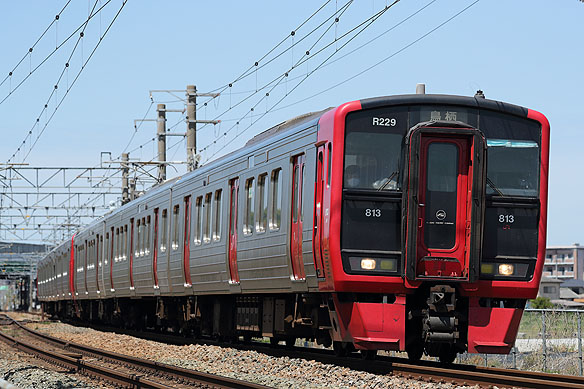Background and overview
In 1997, JR Kyushu introduced the 813-200 series EMUs, incorporating several
design modifications. The driver's cab was widened to enhance safety in
the event of level crossing accidents. Flip-over transverse seating adopted
a cantilevered construction to improve cleanability. Bogies were changed
to types DT403K and TR403K, featuring a single-link traction gear and conical
roller bearings. Bead-processed pier panels were discontinued to reduce
manufacturing costs.
Modifications
Seating Removal and Reclassification (-2200 Subseries)
Beginning in 2021, transverse seats located immediately adjacent to the doors of 813-200 series cars were removed to increase passenger capacity. All units underwent this modification and were reclassified as the -2200 subseries. This change aimed to mitigate delays during rush hours caused by extended boarding and alighting times.
External Security Camera Installation (-3400 Subseries)
In 2022, certain units were equipped with external security cameras on the vehicle sides to enable conductor-less operation. These modified vehicles were reclassified under the -3400 subseries.
Formation of 6-Car Sets (-600 Subseries)
In 2024, select 3-car formations of the 813-200 series were combined to create 6-car sets. This involved deactivation of the driver's cab functionality on end cars and replacement of transverse seating between doors with longitudinal bench seating. These sets were reclassified into the -600 subseries. Specifically:
- Class Kumoha813-200 cars positioned mid-train were reclassified as Class Moha813-600.
- Class Kuha813-200 cars became Class Saha813-600.
Former cab ends were also retrofitted with prominent anti-fall plates for passenger safety.
Operations
The 813-200, -2200, and -600 subseries are currently deployed on rapid and local services across the Kagoshima, Nippo, Nagasaki, Chikuhou, and Sasaguri lines. |
|





